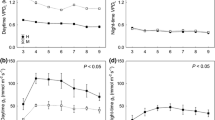Abstract
In situ gas-exchange data, for branchlets of white spruce [Picea glauca (Moench) Voss.] in a mature mixed-wood boreal forest in central Canada (53°44´N 105°14´W), were subjected to a multiple regression analysis. Vapor pressure deficit (VPD) and branchlet temperature (tleaf) were both significant predictors (P<0.0001) of stomatal conductance to water vapor (gsw) and net photosynthesis (An), together explaining 67 and 64% of the variation in gsw and An, respectively. Since VPD and tleaf were autocorrelated in these field data, but also to further explore the nature of independent effects of temperature and humidity on water and CO2 exchange in white spruce, steady-state gas-exchange was performed on well-watered greenhouse-grown seedlings of white spruce. Results from laboratory experiments supported the following conclusions: (1) Transpiration (E) increases with VPD to an inflection point that increases linearly with tleaf. This tleaf effect on E could not be explained by trends in VPD, RH, An or PFD. Rather, our data support a model in which E and gsw are influenced by the balance between ’supply’ and ’loss’ of water to and from leaf tissue, respectively. The supply of water appears to be in accordance with Darcy’s law, where supply of water is proportional to the driving gradient in pressure/ tension, specific permeability (k), and inverse of water viscosity (n –1). Approximately half of the increase in E could be explained by the linear increase in n –1 with increasing tleaf. We propose that increases in k explain the remainder of the increase in E with tleaf. (2) VPD and tleaf appear to have independent effects on gsw. In contrast, RH effects on gsw or E were subtle and could be explained by a combination of effects of tleaf and VPD. (3) An was affected primarily by tleaf, being reduced at low (10°C) and high (40°C) temperatures, and only indirectly by humidity parameters via stomatal conductance, viz. intercellular CO2 concentrations. Our results have implications for the prediction of water fluxes from plants and canopies in areas where plant temperatures vary diurnally or seasonally.
Similar content being viewed by others
Author information
Authors and Affiliations
Additional information
Received: 24 September 1998 / Accepted: 20 July 1999
Rights and permissions
About this article
Cite this article
Fredeen, A., Sage, R. Temperature and humidity effects on branchlet gas-exchange in white spruce: an explanation for the increase in transpiration with branchlet temperature. Trees 14, 161–168 (1999). https://doi.org/10.1007/s004680050220
Issue Date:
DOI: https://doi.org/10.1007/s004680050220




